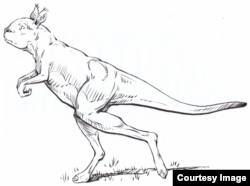Kangaroos hop, right? Well, not all of them.
Scientists said this week that a biomechanical and statistical analysis of fossil bones of a group of huge extinct kangaroos shows that the largest of the bunch in all likelihood could not hop as their modern-day relatives do with aplomb.
The study focused on a group of big-bodied, short-faced kangaroos called sthenurines that lived in Australia from about 13 million years ago until about 30,000 years ago, disappearing after the first humans arrived on the continent.
These kangaroos were more heavily built than modern ones and had faces reminiscent of a rabbit. The largest, a species called Procoptodon goliah, weighed about 530 pounds (240 kg), stood 6-1/2 feet (two meters) tall and was 10 feet long (three meters).
The study found important anatomical differences in sthenurines' limb bones compared with other kangaroos.
In terms of locomotion, they were unlike today's kangaroos, with an anatomy ill-suited for hopping. They likely walked in an upright bipedal stance - putting one foot in front of the other, just like people - in a way modern kangaroos cannot, the study found.
This was facilitated by larger hips and knee joints as well as stabilized ankle joints unlike today's kangaroos but like animals that walk or run. They also had a relatively inflexible spine not conducive for hopping.
"Today's kangaroos mostly use hopping as their fast gait - although tree kangaroos rarely hop. But for slow speeds they use a type of 'pentapedal' walk, using all four legs and the tail," said Brown University paleontologist Christine Janis, who led the study published in the scientific journal PLOS ONE.
With their stiff backs and specialized hands, this "pentapedal" gait would have been difficult for sthenurines.
They also lacked certain specialized anatomical features of modern large hopping kangaroos, the researchers said.
Janis said she suspected smaller sthenurines used bipedal walking at slow speeds and may have switched to hopping at faster speeds. "But the largest ones may have walked rather than hopped most if not all of the time," Janis said.
Virtually all kangaroos today hop, although a species called the Musky Rat-kangaroo does not.
Australia is famous for its marsupials, mammals that carry newborns in a pouch on the mother's abdomen, including kangaroos, koalas, wombats and others.
Procoptodon, the largest known kangaroo, lived from about 125,000 years ago to 30,000 years ago.
"Something the size of Procoptodon would have had a hard time hopping, if it hopped at all," Janis said. "Research on living kangaroos shows that they are close to the limit in terms of tendon strength while hopping."
Procoptodon lived alongside animals like the nearly hippopotamus-sized herbivorous marsupial Diprotodon, the "marsupial lion" Thylacoleo and the giant monitor lizard Megalania that measured roughly 25 feet long (7.5 meters).
Scientists say Procoptodon and its group went extinct possibly because of hunting by humans who arrived in Australia about 50,000 years ago, environmental changes wrought by people or climate changes.









